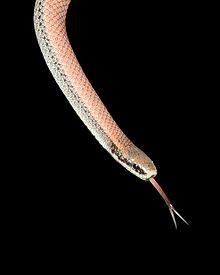- Sharp-tailed snake
-
Sharp-tailed snake 
Scientific classification Kingdom: Animalia Phylum: Chordata Subphylum: Vertebrata Class: Reptilia Order: Squamata Suborder: Serpentes Family: Colubridae Genus: Contia Species: C. tenuis Binomial name Contia tenuis
(Baird & Girard,1852)Synonyms Calamaria tenuis Baird & Girard, 1852
Ablabes purpureocauda Günther, 1858
Homolosoma mite Jan, 1862
Contia mitis - Cope, 1900
Lodia tenuis - Cope, 1900The sharp-tailed snake or sharptail snake (Contia tenuis) is a small, locally common colubrid snake that lives in the western United States.
Contents
Geographic range
It is distributed through the states of California, Oregon, and Washington, as well as British Columbia, Canada.
Description
The sharp-tailed snake averages from eight to twelve inches long as an adult. It is distinguished by its sharp tail spine, which is the protruding tip of the last tail vertebra. The spine is not toxic and cannot injure humans. Rather, the tail is used to stabilize small prey, such as slugs, for consumption. The dorsal surface ranges in color from greyish-brown to brown to brick red, with bubble-gum pink and peachy-orange specimens occasionally found. The ventral surface is a striking series of black and white bars.
Behavior
Sharp-tailed snakes are shy, secretive creatures most often encountered under rocks and logs, and rarely to never found in the open. They are able to persist in urban areas where appropriate cover can be found. They are known to burrow into soft soil or cracks in the clay, and may be encountered by people who are digging in the garden or removing concrete. When encountered, sharp-tailed snakes may roll into a ball and remain still. They can be mistaken for worms to the casual observer. Their diet is largely restricted to slugs and insects.
Reproduction
4-16 eggs are laid in the summer, underground or in a burrow. Young are 3-4 inches long.
Taxonomy
Recently, extensive studies on this reptile have shown definite differences that may prove to be a new species.[citation needed] The maximum length is 17-18 inches, with different scaling, as well as a longer tail. The species range extends from southern British Columbia to southern Sierra Nevada and to the central coast of California. The fragmented distribution of the snake in the northern part of its range suggests that populations in British Columbia are relics of a more extensive previous distribution.[citation needed] Seven sites are known in the province, all located on the Gulf Islands and in southeastern Vancouver Island. In 1996-97 the persistence of the snakes was confirmed at four of the seven sites, where they appeared to be confined to habitat patches of about 2 km in diameter.[citation needed] The secretive habits and seasonal activity pattern of the snakes make it difficult to assess their distribution and accurately estimate population densities.
External links
- Contia tenuis - Description, Risk Status
- Contia tenuis - Sharp-tailed Snake - Description, Pictures
This Colubrids article is a stub. You can help Wikipedia by expanding it.
